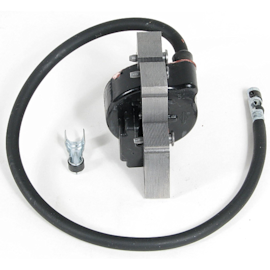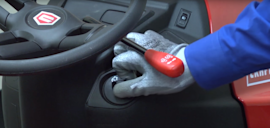Riding lawn mower engine clicks but doesn't turn over video


If your riding lawn mower engine clicks when you turn the key but won’t turn over, there’s a pretty good chance your mower could have a bad starter solenoid. Other problems, though not as frequent, include a bad starter motor, a wiring failure, a weak battery or a locked-up engine.
This video shows how to troubleshoot the most likely causes, so you can find out what's wrong and get back to mowing. For additional repair help—including common symptoms and troubleshooting tips, and step-by-step riding mower repair guides and articles—check out our repair help section.
Hi, Wayne here from Sears PartsDirect. Today we're going to talk about troubleshooting a riding lawn mower engine that clicks when you turn the key but won’t turn over.
A bad starter solenoid often causes this problem—but not always. The mower could have a bad starter motor, a wiring failure, a weak battery or a locked-up engine. We'll show you how to find out what's wrong.
Supplies you might need
Work gloves and safety goggles
Wire brush
Baking soda and water
Petroleum jelly
Clip-on meter probes
Check for a weak battery
First, we’ll check for a weak battery. The click you hear when you turn the key means that the starter solenoid coil is getting power.
The starter solenoid only needs a little current to make the solenoid coil click, but the starter motor needs a lot of current to spin the motor. So a weak battery could have enough current to trip the solenoid coil but not enough current to crank the engine.
To check the battery, use a multimeter to measure the DC voltage across the battery terminals.
Turn off the ignition.
Access the battery—in this type of riding lawn mower, you lift the seat to get to the battery.
With the multimeter set to measure DC voltage, touch the red multimeter probe to the positive or red battery terminal and the black meter probe to the negative or black battery terminal.
A fully charged battery measures more than 12 volts DC. To provide enough current to spin the starter motor, the battery typically needs to be at least 75 percent charged.
Charge the battery if it's weak or dead. The starter motor should spin the engine after you recharge the battery. If not, the next step is to check the battery cables.
Check the battery cables
If the battery is okay, then corroded or broken wire cables could prevent the starter motor from getting power.
Removing corrosion. If you find corrosion on the battery terminals and cable ends, here’s how to safely remove it:
Put on work gloves and safety goggles.
Disconnect the negative cable and then the positive cable from the battery.
Use a wire brush to clean the cable ends and battery terminals. If brushing doesn’t remove it all, sprinkle baking soda over the terminals and cable ends and then moisten the baking soda. The baking soda and water will bubble vigorously and dissolve the corrosion. When bubbling stops, use a toothbrush to remove any remaining corrosion.
Wipe off the terminals and cable ends with a shop rag.
Using a shop rag, thinly coat the battery terminals with petroleum jelly to help prevent corrosion.
Testing the cables. If you found no corrosion, or if the motor still won’t start after you remove corrosion, check if the red battery cable is delivering power to the solenoid post by measuring voltage on the red terminal post.
With the multimeter set to measure DC voltage, touch the red meter probe to the red post on the starter solenoid and the black meter probe to the negative terminal on the battery. It should measure more than 12 volts. If it doesn’t, replace the red battery cable.
A word of warning here: Don’t let the meter lead touch both the solenoid posts at the same time or you’ll see a severe spark.
If the motor still doesn’t turn over with a good red cable, the solenoid is next on the list of likely suspects.
Test the starter solenoid
Next, we'll check the starter solenoid by measuring voltage on the black post at the same time as the solenoid clicks.
You'll need some clip-on meter probes to hold the probes on the wires as you turn the ignition key, unless you have a helper to turn the key while you hold the probes on the wires.
Disconnect the black starter cable from the solenoid post and attach the red meter probe to the post.
Clip the black meter probe to the negative battery terminal.
Hold the ignition key in the start position—you should hear the solenoid coil click.
Check the voltage reading and then turn the key to the off position.
When the solenoid coil clicked, the multimeter measured more than 12 volts if the black post gets power. If it measured no voltage when the solenoid coil clicked, replace the starter solenoid. Here's a video that shows you how.
Test the starter cable
If the multimeter measured more than 12 volts on the black solenoid post after the solenoid clicked, you know that the starter solenoid works. Now we'll check the starter cable that connects the solenoid to the starter.
To check the starter cable, we’ll use a voltage drop test to measure resistance through the starter cable. Using a voltage drop test is more accurate than a simple resistance test for a large cable with many copper strands, because a simple resistance check simply detects any current; it can’t detect whether the cable can carry enough current to spin the starter motor.
We measure voltage—also called voltage drop—from the solenoid post to the starter motor stud. Ideally, we should measure less than 1 volt during this test, indicating voltage is nearly the same at the solenoid post and the starter motor stud. If it’s more than 1 volt, it means wire strands inside the cable are broken.
To start the test, reconnect the black starter cable to the solenoid post and clip the red meter probe to the black post.
Lift the mower hood and disconnect the spark plug wire so the engine has no chance of starting.
Clip the black meter lead to the starter motor stud that connects the black cable to the starter.
Hold the ignition key in the start position and check the voltage reading after the click. Turn the key to the off position after checking the voltage.
If you measure a drop of more than 1 volt through the starter cable, replace the starter cable.
Check for a seized engine
If the starter cable is okay, you know that the starter motor is getting power.
Since the motor isn't turning, we’ve narrowed the failure down to a seized engine or a failed starter motor.
We'll check for a seized engine and if it’s not locked up, we’ll know that the starter motor failed.
To see if the engine spins, remove the plug from the screen above the flywheel to access the flywheel bolt. Use a socket wrench to rotate the flywheel bolt clockwise and try to spin the engine. If the engine won’t spin because it’s locked up, have a service technician diagnose and repair the problem.
If you can spin the engine, replace the starter motor because it’s not spinning the engine when activated.
If you follow these troubleshooting steps, you should be able to get that riding lawn mower engine started so you can get back to mowing.
I hope this video helped you out today. Check out our other videos on the Sears PartsDirect YouTube channel and subscribe to get notices when we post new ones.
Most common symptoms to help you fix your riding mowers & tractors
Choose a symptom to see related riding mower and lawn tractor repairs.
Main causes: worn or broken blade belt, broken belt idler pulley, blade clutch cable failure, bad PTO switch, damaged ma…
Main causes: faulty battery, bad alternator…
Main causes: punctured tire or inner tube, leaky valve stem, damaged wheel rim…
Main causes: dead battery, stale fuel, bad starter solenoid, ignition system problem, bad ignition interlock switch, clo…
Main causes: damaged tie rods, bent or worn wheel spindle, worn front axle, damaged sector gear assembly…
Main causes: shift lever needs adjustment, neutral control needs adjustment…
Main causes: clogged carburetor, damaged flywheel key, dirty spark plug, stale fuel, improper valve lash, engine needs a…
Main causes: worn or broken ground drive belt, bad seat switch, transaxle freewheel control engaged, transaxle failure, …
Main causes: unlevel mower deck, dull or damaged cutting blades, worn mandrel pulleys, bent mower deck, engine needs tun…
Most common repair guides to help fix your riding mowers & tractors
These step-by-step repair guides will help you safely fix what’s broken on your riding mower or lawn tractor.

How to replace a mandrel assembly on a riding lawn mower
Replace the mandrel assembly if the blade shaft vibrates or doesn't spin.…

How to replace the flywheel key on a riding lawn mower
If the engine won't restart after hitting a stump or rock, the problem could be a sheared flywheel key. Follow these ste…

How to replace a riding lawn mower ignition coil
If you're not getting spark from a good spark plug, the problem could be the ignition coil. Follow these step-by-step in…
Effective articles & videos to help repair your riding mowers & tractors
Use the advice and tips in these articles and videos to get the most out of your riding mower or lawn tractor.

Learn about all the convenient features on our Sears PartsDirect website that make your parts purchases easier.…

Get answers to frequently asked questions about Sears and Sears PartsDirect.…

Check the starter solenoid, starter motor, wiring, battery and engine.…